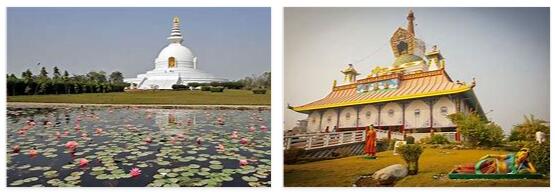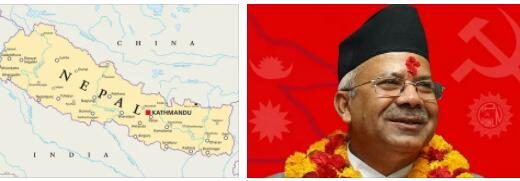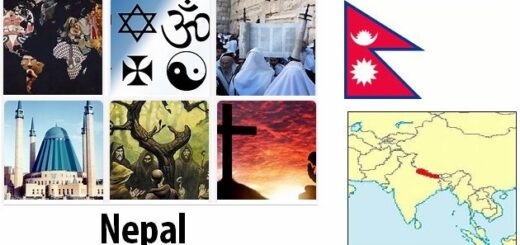Lumbini – Birthplace of Buddha (World Heritage)
Lumbini is considered the birthplace of the Buddha and is an important place of pilgrimage. Siddhartha Gautama, the later Buddha, is said to have been there in 560 BC. Be born in a grove. The site was not rediscovered until the 19th century. The most important find is a 6.5 m high stone column dating from 245 BC. BC by King Ashoka (273–232 BC), the ruler of the Indian Maurya dynasty, in memory of Buddha.
Lumbini – Birthplace of Buddha: Facts
| Official title: | Lumbini (birthplace of the Buddha) |
| Cultural monument: | the birthplace of Buddha in the »Pleasure Garden of Lumbini« |
| Continent: | Asia |
| Country: | Nepal, Terai |
| Location: | Lumbini |
| Appointment: | 1997 |
| Meaning: | the birthplace of Buddha as an extremely important Buddhist pilgrimage site |
Lumbini – Buddha’s Birthplace: History
| 563 BC Chr. | Birth of Siddharta Gautama, also known as “Shakyamuni” |
| 483 BC Chr. | Death (entry into the so-called “Parinirwana”, the complete extinction) of Siddharta Gautama |
| 250 BC Chr. | A stone pillar was erected at the Buddha’s birthplace on the orders of Emperor Ashoka |
| 7th century | Description of Lumbini by the Chinese pilgrim Xuanzang |
| 1895/96 | Rediscovery by General Khadga Shamsher JB Rana and Dr. Alois Anton leader |
| 1933-39 | Excavations under General Khadga Shamsher JB Rana |
| 1970/71 and 1977/78 | Excavations by Japanese archaeologists |
The cradle of the enlightened
No noisy crowds of pilgrims, no devotional stalls filled with kitsch, no ringing bells, no roaring bus engines in overcrowded parking lots – instead, birdsong, the rustling of the wind in ancient Bodhi trees and now and then the bright, orange robe of a monk as a colored swab in a tropical green landscape that has hardly changed her face for centuries.
Lumbini is certainly not a destination that celebrates one of the world’s great religions with monumental architecture. A few trees, the scant remains of a temple, a few foundation walls – the visitor cannot expect more. Nevertheless – or precisely because of this – the holy grove with its calm and peacefulness is able to enchant the visitor in a very special way. It was here that Gautama Buddha, one of the great religious founders of mankind, was born to Maya Devi, wife of the governor of the Shakya republic of the Kapilavastu kingdom. Legend has it that at the time of her birth, Maya stayed in the Lumbini grove. As she reached out to a sal tree, the little Buddha stepped from her right side. After his birth, Buddha took seven steps in the four directions, and wherever he touched the earth, a lotus blossomed. Buddha’s mother died just seven days after the birth. After a well-protected childhood and youth, Gautama Buddha left his family overnight. The encounters with an old man, a sick man, a corpse and an ascetic had changed his life, made him aware of the transience and suffering of earthly existence and awakened in him the desire to overcome the world – the basis of the new teaching.
After years of asceticism as a beggar, he found the path of the “center right” and attained enlightenment in Bodh-Gaya in order to spread the teaching of overcoming suffering in northern India: “The rebirth is abolished, the holy walk done, done is what had to be done, after this life there is no other. “With his” complete extinction “at the end of the fifth century BC, he entered the redeeming nothingness from the eternal cycle of rebirths. At the time when Buddhism spread in India and the neighboring countries, especially in the third century BC under Emperor Ashoka, the most zealous missionary of the new faith, Lumbini was firmly rooted as a pilgrimage destination in the world of Buddhism. However, with the decline of religion in their ancestral homeland and the conquest of India by Islam, the sacred grove gradually fell into oblivion. It was not until the 19th century that the British rulers in India began looking for the historic site. But it wasn’t until the end of that century that General Khadga Shamsher Rana and the archaeologist Dr. Alois Anton Führer on a hunting excursion by chance on the capital of the rubble-covered Ashoka column, the inscription of which meant the end of all speculation: “I arranged for a column to be erected with the thought: This is where Buddha Shakyamuni was born.” No further proof was needed – Lumbini had been rediscovered. A few years later, a close examination of a heavily weathered, Reliefs still venerated that it was a representation of the birth of Buddha. Even the last doubts were now gone. The first, unsuitable restoration work soon began, including the water basin in which Maya is said to have bathed after the birth of the Buddha. A shrine was built on the ruins of the adjacent Mayan temple to house the reliefs found here. Lumbinis especially devoted himself to Japan, in which Buddhism still plays a central role. According to the ideas of the architect Kenzo Tange, who died in 2005, a modern pilgrim and tourist village was created there, designed as an extensive landscape park with a cultural center and museums dedicated to the life of Buddha and Buddhist teachings.



